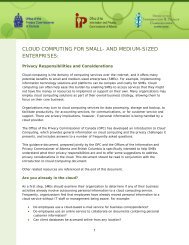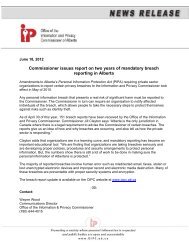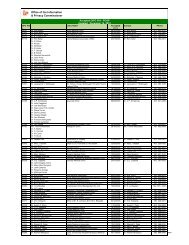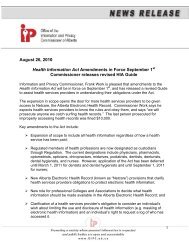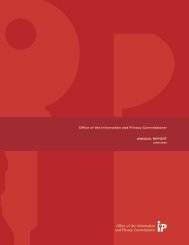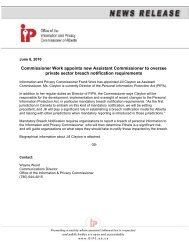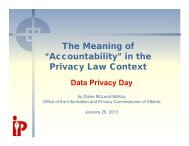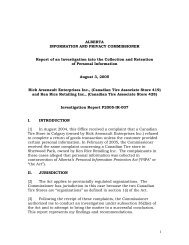Investigation Report P2005-IR-005 - Office of the Information and ...
Investigation Report P2005-IR-005 - Office of the Information and ...
Investigation Report P2005-IR-005 - Office of the Information and ...
You also want an ePaper? Increase the reach of your titles
YUMPU automatically turns print PDFs into web optimized ePapers that Google loves.
ALBERTA<br />
INFORMATION AND PRIVACY COMMISSIONER<br />
<strong>Report</strong> <strong>of</strong> an <strong>Investigation</strong> into <strong>the</strong> Disclosure <strong>of</strong> Personal<br />
<strong>Information</strong> During <strong>the</strong> Course <strong>of</strong> a Business Transaction<br />
July 12, 2<strong>005</strong><br />
Builders Energy Services Ltd., Stikeman Elliott LLP,<br />
Shtabsky & Tussman LLP <strong>and</strong> Remote Wireline Services Ltd.<br />
<strong>Investigation</strong> <strong>Report</strong> <strong>P2<strong>005</strong></strong>-<strong>IR</strong>-<strong>005</strong><br />
I. INTRODUCTION<br />
[1] On February 14, 2<strong>005</strong>, <strong>the</strong> <strong>Office</strong> <strong>of</strong> <strong>the</strong> <strong>Information</strong> <strong>and</strong> Privacy<br />
Commissioner (“<strong>the</strong> Commissioner”) received a complaint that Builders<br />
Energy Services Ltd. (“Builders”), Remote Wireline Services Ltd.<br />
(“Remote”) <strong>and</strong> two law firms, Stikeman Elliott LLP (“Stikemans”) <strong>and</strong><br />
Shtabsky & Tussman LLP (“Shtabsky & Tussman”) failed to comply with<br />
Alberta’s Personal <strong>Information</strong> Protection Act (“PIPA” or “<strong>the</strong> Act”) by<br />
improperly disclosing personal information, ga<strong>the</strong>red through a business<br />
acquisition, onto <strong>the</strong> world wide web.<br />
II.<br />
JURISDICTION<br />
[2] The Act applies to provincially regulated organizations in Alberta.<br />
The Commissioner has jurisdiction in this case because Builders is<br />
incorporated in Alberta, operating in Alberta <strong>and</strong> governed by <strong>the</strong> laws <strong>of</strong><br />
<strong>the</strong> province <strong>of</strong> Alberta, <strong>and</strong> is <strong>the</strong>refore an “organization” under <strong>the</strong> Act.<br />
Remote has now been acquired by Builders, <strong>and</strong> continues to carry on<br />
business in Alberta. Likewise, both Stikemans <strong>and</strong> Shtabsky & Tussman<br />
1
are law firms registered <strong>and</strong> doing business in <strong>the</strong> province <strong>of</strong> Alberta<br />
<strong>and</strong>, <strong>the</strong>refore, are “organizations” under <strong>the</strong> Act.<br />
[3] On February 28, 2<strong>005</strong>, <strong>the</strong> Commissioner authorized this <strong>Office</strong> to<br />
conduct an investigation under subsection 36(2)(e) <strong>of</strong> <strong>the</strong> Act <strong>and</strong> to<br />
attempt to bring <strong>the</strong> matter to a successful conclusion. This report<br />
represents our findings.<br />
III.<br />
INVESTIGATION<br />
[4] In conducting this investigation, we interviewed <strong>the</strong> complainant<br />
(an affected Builders employee), members <strong>of</strong> Builders’ management team,<br />
lawyers from Stikemans, <strong>and</strong> a lawyer representing Shtabsky &<br />
Tussman. We examined <strong>the</strong> purchase & sale agreements <strong>and</strong> schedules<br />
relating to all <strong>of</strong> <strong>the</strong> acquisitions in question, <strong>the</strong> Builders’ Prospectus,<br />
Builders’ Privacy Policy <strong>and</strong> Stikemans’ draft privacy policy.<br />
IV.<br />
STATEMENT OF AGREED FACTS<br />
[5] In <strong>the</strong> autumn <strong>of</strong> 2004, Builders started <strong>the</strong> process to acquire<br />
securities <strong>of</strong> entities that provide oilfield services to <strong>the</strong> western<br />
Canadian oil <strong>and</strong> gas industry (hereinafter “<strong>the</strong> Transaction”) <strong>and</strong> to<br />
conduct an Initial Public Offering (“IPO”). The IPO closed concurrently<br />
with <strong>the</strong> closing <strong>of</strong> acquisitions <strong>of</strong> nine oilfield service businesses:<br />
Brazeau Well Servicing Ltd., Decarson Rentals (2000) Inc., Circle D<br />
Transport Inc., Ken Polege Enterprises Ltd., <strong>the</strong> CTC Group (CTC Coil<br />
Tubing Completions Ltd., CTC Nitrogen Services Ltd. <strong>and</strong> CTC<br />
Production Testing Ltd.), Remote Wireline Services Ltd. (“Remote”), <strong>and</strong><br />
CDT Rentals Inc. (collectively “<strong>the</strong> Acquired Companies”). On January 25,<br />
2<strong>005</strong>, Builders amalgamated with all nine <strong>of</strong> <strong>the</strong> Acquired Companies<br />
but continued to operate each <strong>of</strong> <strong>the</strong> businesses <strong>of</strong> <strong>the</strong> Acquired<br />
Companies under <strong>the</strong>ir current operating name. As a result <strong>of</strong> <strong>the</strong><br />
amalgamation, Builders became liable for all <strong>of</strong> <strong>the</strong> Acquired Companies’<br />
obligations.<br />
[6] Builders retained Stikemans as its legal counsel. Each <strong>of</strong> <strong>the</strong> nine<br />
Acquired Companies retained <strong>the</strong>ir own separate legal counsel to advise<br />
<strong>the</strong>m during <strong>the</strong> course <strong>of</strong> <strong>the</strong> Transaction. Specifically, Remote retained<br />
<strong>the</strong> law firm <strong>of</strong> Shtabsky & Tussman.<br />
[7] During <strong>the</strong> course <strong>of</strong> <strong>the</strong> Transaction, purchase <strong>and</strong> sale<br />
agreements were drafted for <strong>the</strong> purpose <strong>of</strong> each individual acquisition.<br />
These agreements were largely similar, but each reflected specific<br />
circumstances that were unique to each Acquired Company. Each<br />
Acquired Company provided representations <strong>and</strong> warranties to Builders<br />
2
in <strong>the</strong> course <strong>of</strong> <strong>the</strong> Transaction. The fulfilment <strong>of</strong> <strong>the</strong> representations<br />
<strong>and</strong> warranties by <strong>the</strong> Acquired Companies was a condition <strong>of</strong> <strong>the</strong><br />
Transaction.<br />
[8] Specifically in s. 3.2 <strong>of</strong> <strong>the</strong> purchase <strong>and</strong> sale agreement between<br />
Builders <strong>and</strong> Remote (“<strong>the</strong> Remote Agreement”), Remote <strong>and</strong> its<br />
shareholders provided to Builders certain representations <strong>and</strong> warranties<br />
in respect <strong>of</strong> employment matters:<br />
“3.2(z) except as set forth in Schedule 3.2(z), <strong>the</strong> Corporation is not a<br />
party to any written employment contract, consulting agreement,<br />
collective bargaining agreement or employee association agreement;<br />
<strong>the</strong> Corporation has not conducted <strong>and</strong> is not now conducting any<br />
negotiations with any labour unions or employee associations; <strong>the</strong><br />
Corporation has complied with all <strong>of</strong> its obligations in respect <strong>of</strong><br />
employment insurance programs, Canada Pension Plan payments<br />
<strong>and</strong> Worker’s Compensation payments;<br />
(aa) <strong>the</strong> only employees <strong>of</strong> <strong>the</strong> Corporation are listed in Schedule<br />
3.2(z);<br />
(bb) all Employee Plans are listed in Schedule 3.2(z) <strong>and</strong>;<br />
(i) <strong>the</strong> Corporation has paid or provided for all<br />
liabilities for wages, vacation pay, salaries,<br />
bonuses, pensions <strong>and</strong> all o<strong>the</strong>r amounts<br />
payable under Employee Plans;<br />
(ii) each <strong>of</strong> <strong>the</strong> Employee Plans complies with <strong>and</strong><br />
has been administered in substantial<br />
compliance with <strong>the</strong> terms <strong>the</strong>re<strong>of</strong> <strong>and</strong> Laws;<br />
<strong>and</strong><br />
(iii) have been, or will by Closing be, terminated<br />
with no fur<strong>the</strong>r Liability <strong>of</strong> <strong>the</strong> Corporation or<br />
Builders.”<br />
[9] Builders requested information from each <strong>of</strong> <strong>the</strong> Acquired<br />
Companies to complete <strong>the</strong> schedules <strong>and</strong> satisfy <strong>the</strong> representations<br />
<strong>and</strong> warranties. The information required for <strong>the</strong> schedules would<br />
include a list <strong>of</strong> employee names, a list <strong>of</strong> any employment agreements,<br />
<strong>and</strong> details regarding any employee benefits plans. Stikemans advised us<br />
that typically on transactions <strong>of</strong> this nature, only names <strong>and</strong> position<br />
titles <strong>of</strong> employees are included in such schedules. Builders advised that<br />
it did not request ei<strong>the</strong>r employee home addresses or Social Insurance<br />
Numbers (“SINs”) from <strong>the</strong> Acquired Companies.<br />
[10] Builders did not request <strong>the</strong> information for <strong>the</strong> employee<br />
3
schedules in writing from <strong>the</strong> Acquired Companies. Because <strong>of</strong> <strong>the</strong><br />
nature <strong>of</strong> <strong>the</strong> acquired businesses, <strong>and</strong> <strong>the</strong>ir size, Builders<br />
communicated many <strong>of</strong> <strong>the</strong> requirements for <strong>the</strong> Transaction over <strong>the</strong><br />
telephone or in person instead <strong>of</strong> in writing. <strong>Information</strong> was supplied to<br />
Builders by principals <strong>and</strong> agents <strong>of</strong> <strong>the</strong> Acquired Companies <strong>and</strong> to<br />
Stikemans by principals <strong>and</strong> legal counsel <strong>of</strong> <strong>the</strong> Acquired Companies.<br />
[11] Specifically with respect to <strong>the</strong> Remote Agreement, a Remote<br />
employee provided <strong>the</strong> employee schedule to Shtabsky & Tussman for<br />
use in <strong>the</strong> business transaction. Shtabsky & Tussman in turn disclosed<br />
<strong>the</strong> schedule to Stikemans. This employee schedule identified all <strong>of</strong> <strong>the</strong><br />
Remote employees, with <strong>the</strong>ir home addresses <strong>and</strong> SINs (even though<br />
SINs had not been requested). We will hereinafter refer to <strong>the</strong> disclosure<br />
<strong>of</strong> this employee schedule by Shtabsky & Tussman to Stikemans as “<strong>the</strong><br />
First Disclosure”.<br />
[12] The personal information disclosed by Shtabsky & Tussman was<br />
not provided to Stikemans subject to any solicitors’ trust conditions or<br />
undertakings.<br />
[13] It is unclear whe<strong>the</strong>r anyone at Shtabsky & Tussman reviewed <strong>the</strong><br />
contents <strong>of</strong> <strong>the</strong> schedule before disclosing it to Stikemans.<br />
[14] Stikemans received <strong>the</strong> Remote employee schedule <strong>and</strong> provided it<br />
to Builders for <strong>the</strong>ir review <strong>and</strong> sign-<strong>of</strong>f. Stikemans did not notice that<br />
<strong>the</strong> schedule included home addresses or SINs. As with Shtabsky &<br />
Tussman, it is unclear whe<strong>the</strong>r anyone at Stikemans reviewed <strong>the</strong><br />
contents <strong>of</strong> <strong>the</strong> schedule.<br />
[15] Builders reviewed all <strong>of</strong> <strong>the</strong> schedules primarily with a view to<br />
ensuring that all documents were included; <strong>the</strong>y submit that <strong>the</strong>y relied<br />
on Stikemans to advise <strong>the</strong>m <strong>of</strong> <strong>the</strong> legality <strong>and</strong> responsiveness <strong>of</strong> <strong>the</strong><br />
information contained in <strong>the</strong> documents. Once Builders signed <strong>of</strong>f on<br />
<strong>the</strong> schedules, Stikemans <strong>the</strong>n attached <strong>the</strong>m to <strong>the</strong> Remote Agreement.<br />
[16] Securities legislation requires public companies such as Builders<br />
to disclose all material contracts on <strong>the</strong> System for Electronic Document<br />
Analysis <strong>and</strong> Retrieval (“SEDAR”). SEDAR was developed in Canada for<br />
<strong>the</strong> Canadian Securities Administrators to:<br />
• facilitate <strong>the</strong> electronic filing <strong>of</strong> securities information as<br />
required by <strong>the</strong> securities regulatory agencies in Canada;<br />
• allow for <strong>the</strong> public dissemination <strong>of</strong> Canadian securities<br />
information collected in <strong>the</strong> securities filing process; <strong>and</strong><br />
4
• provide electronic communication between electronic filers,<br />
agents <strong>and</strong> <strong>the</strong> Canadian securities regulatory agencies<br />
[17] As <strong>the</strong> Remote Agreement is considered a material contract,<br />
Stikemans disclosed <strong>and</strong> filed <strong>the</strong> Remote Agreement on SEDAR on<br />
January 25, 2<strong>005</strong>, including all schedules. We will refer to Stikemans’<br />
disclosure <strong>of</strong> <strong>the</strong> employee schedule through posting on SEDAR as “<strong>the</strong><br />
Second Disclosure”.<br />
[18] There is no log-in or password requirement to access documents<br />
that are posted on SEDAR’s website. <strong>Information</strong> posted on SEDAR is<br />
accessible to anyone browsing its website. Indeed, one <strong>of</strong> SEDAR’s<br />
objectives is <strong>the</strong> efficient public dissemination <strong>of</strong> securities information.<br />
[19] Builders became aware <strong>of</strong> <strong>the</strong> resulting disclosure <strong>of</strong> employees’<br />
names, home addresses <strong>and</strong> SINs on SEDAR when a Remote employee<br />
brought it to <strong>the</strong>ir attention on February 9, 2<strong>005</strong>. As only <strong>the</strong> Alberta<br />
Securities Commission can remove information from SEDAR, Builders<br />
was unable to immediately retract <strong>the</strong> information from <strong>the</strong> website.<br />
Removal <strong>of</strong> <strong>the</strong> employee schedule from SEDAR’s website occurred on<br />
February 11, 2<strong>005</strong>.<br />
[20] It is not known how many individuals accessed this information on<br />
SEDAR’s website between January 25, 2<strong>005</strong> <strong>and</strong> February 11, 2<strong>005</strong>.<br />
V. ISSUES<br />
[21] To resolve this matter, two questions must be determined:<br />
1. Were <strong>the</strong> First <strong>and</strong> Second Disclosures <strong>of</strong> personal information in<br />
compliance with Part 2 <strong>of</strong> PIPA?<br />
2. If not, who is accountable for <strong>the</strong> unauthorized disclosures?<br />
VI.<br />
ANALYSIS<br />
1. Were <strong>the</strong> First <strong>and</strong> Second Disclosures <strong>of</strong> personal<br />
information in compliance with PIPA?<br />
[22] Part 2, Division 6 <strong>of</strong> <strong>the</strong> Act deals with <strong>the</strong> collection, use <strong>and</strong><br />
disclosure <strong>of</strong> personal information during <strong>the</strong> course <strong>of</strong> a business<br />
transaction. “Business transaction” is defined in subsection 22(1)(a) <strong>of</strong><br />
<strong>the</strong> Act as follows:<br />
5
“… a transaction consisting <strong>of</strong> <strong>the</strong> purchase, sale, lease, merger or<br />
amalgamation or any o<strong>the</strong>r type <strong>of</strong> acquisition or disposal <strong>of</strong>, or <strong>the</strong><br />
taking <strong>of</strong> a security interest in respect <strong>of</strong>, an organization or a<br />
portion <strong>of</strong> an organization or any business or activity or business<br />
asset <strong>of</strong> an organization <strong>and</strong> includes a prospective transaction <strong>of</strong><br />
such a nature.”<br />
[23] The acquisition <strong>of</strong> Remote <strong>and</strong> <strong>the</strong> o<strong>the</strong>r Acquired Companies in<br />
this case was clearly a “business transaction” as contemplated by <strong>the</strong><br />
Act.<br />
[24] PIPA subsection 22(3)(a) allows parties to a business transaction to<br />
collect, use <strong>and</strong> disclose personal information without <strong>the</strong> consent <strong>of</strong> <strong>the</strong><br />
individual if :<br />
“(If…) (i) <strong>the</strong> parties have entered into an agreement under which <strong>the</strong><br />
collection, use <strong>and</strong> disclosure <strong>of</strong> <strong>the</strong> information is restricted to those<br />
purposes that relate to <strong>the</strong> business transaction, <strong>and</strong><br />
(ii) <strong>the</strong> information is necessary<br />
(A) for <strong>the</strong> parties to determine whe<strong>the</strong>r to proceed with<br />
<strong>the</strong> business transaction, <strong>and</strong><br />
(B) if <strong>the</strong> determination is to proceed with <strong>the</strong> business<br />
transaction, for <strong>the</strong> parties to carry out <strong>and</strong> complete<br />
<strong>the</strong> business transaction…”<br />
[25] Prior to <strong>the</strong> Transaction, Builders entered into confidentiality<br />
agreements with each <strong>of</strong> <strong>the</strong> Acquired Companies. Specifically with<br />
respect to Remote, <strong>the</strong> confidentiality agreement provides that all<br />
confidential information shall only be used, dealt with or exploited for <strong>the</strong><br />
purposes <strong>of</strong> evaluating a possible transaction. We are <strong>the</strong>refore satisfied<br />
that <strong>the</strong> parties complied with subsection 22(3)(a)(i) <strong>of</strong> PIPA.<br />
[26] The remainder <strong>of</strong> this analysis will deal with whe<strong>the</strong>r <strong>the</strong>re was<br />
compliance with subsection 22(3)(a)(ii): whe<strong>the</strong>r <strong>the</strong> information<br />
disclosed was necessary for <strong>the</strong> purposes <strong>of</strong> determining whe<strong>the</strong>r to<br />
proceed with <strong>the</strong> transaction, <strong>and</strong> <strong>of</strong> carrying out <strong>and</strong> completing <strong>the</strong><br />
transaction.<br />
a. The First Disclosure<br />
[27] In respect <strong>of</strong> <strong>the</strong> First Disclosure, we find that it fails to satisfy <strong>the</strong><br />
requirements <strong>of</strong> PIPA paragraph 22(3)(a)(ii); i.e., we find <strong>the</strong> personal<br />
information disclosed was not “necessary” for <strong>the</strong> purposes <strong>of</strong> <strong>the</strong><br />
business transaction.<br />
6
[28] Certain types <strong>of</strong> personal information about employees <strong>of</strong> an<br />
organization will be “necessary” for <strong>the</strong> purposes <strong>of</strong> a transaction<br />
involving acquisition <strong>of</strong> <strong>the</strong> shares or assets <strong>of</strong> that organization. The<br />
facts <strong>of</strong> each case will govern, <strong>of</strong> course, but examples <strong>of</strong> personal<br />
information that may be “necessary” include <strong>the</strong> names <strong>and</strong> titles <strong>of</strong><br />
employees, descriptions <strong>of</strong> positions <strong>and</strong> functions, description <strong>of</strong> an<br />
individual’s place in <strong>the</strong> acquired organization’s management structure,<br />
<strong>and</strong>, in some cases, salary levels. Fur<strong>the</strong>rmore, outst<strong>and</strong>ing employee<br />
litigation, whe<strong>the</strong>r <strong>the</strong> employee belongs to <strong>the</strong> organization’s benefit<br />
plan, stock purchase plan, pension plan, or collective bargaining unit,<br />
are similarly factors that may be necessary in order to determine whe<strong>the</strong>r<br />
to proceed or conclude <strong>the</strong> business transaction. Again, depending on<br />
<strong>the</strong> facts <strong>of</strong> <strong>the</strong> case, <strong>the</strong>se are examples <strong>of</strong> personal information that<br />
likely have <strong>the</strong> ability to affect <strong>the</strong> decision to proceed or <strong>the</strong> terms on<br />
which a transaction proceeds (including price).<br />
[29] Builders did not request <strong>the</strong> employee home addresses or SINs as<br />
part <strong>of</strong> <strong>the</strong> information ga<strong>the</strong>ring for <strong>the</strong> schedules from any <strong>of</strong> <strong>the</strong><br />
Acquired Companies. Typically, only employee names are requested as<br />
part <strong>of</strong> <strong>the</strong>se schedules. None<strong>the</strong>less, home addresses <strong>and</strong> SINs were<br />
supplied by Remote to its counsel Shtabsky & Tussman.<br />
[30] We find that <strong>the</strong> employees’ home addresses <strong>and</strong> SINs were not<br />
necessary for concluding <strong>the</strong> transaction. Both <strong>the</strong> home address <strong>and</strong><br />
SIN would only ever be reasonably collected, used or disclosed once an<br />
individual became an employee <strong>of</strong> an organization.<br />
[31] In summary, <strong>the</strong> personal information that is <strong>the</strong> subject <strong>of</strong> <strong>the</strong><br />
First Disclosure (with <strong>the</strong> exception <strong>of</strong> <strong>the</strong> employees’ names) does not<br />
meet <strong>the</strong> criteria in section 22 <strong>of</strong> <strong>the</strong> Act. As such, <strong>the</strong> business<br />
transaction exception does not apply to <strong>the</strong> employees’ home addresses<br />
<strong>and</strong> SINs.<br />
[32] Absent <strong>the</strong> business transaction exception, PIPA may none<strong>the</strong>less<br />
authorize <strong>the</strong> use <strong>and</strong> disclosure <strong>of</strong> personal information <strong>and</strong> personal<br />
employee information without <strong>the</strong> consent <strong>of</strong> <strong>the</strong> individual or employee.<br />
We will consider in turn <strong>the</strong> provisions <strong>of</strong> PIPA pertaining to personal<br />
employee information <strong>and</strong> personal information to determine whe<strong>the</strong>r <strong>the</strong><br />
First Disclosure was o<strong>the</strong>rwise authorized under <strong>the</strong> Act.<br />
[33] “Personal employee information” is defined in PIPA subsection 1(j)<br />
as personal information in respect <strong>of</strong> an individual who is an employee or<br />
potential employee <strong>of</strong> an organization whose personal information is<br />
reasonably required by an organization for <strong>the</strong> sole purposes <strong>of</strong><br />
establishing, managing or terminating <strong>the</strong> employment relationship, but<br />
7
does not include personal information about <strong>the</strong> employee that is<br />
unrelated to that relationship.<br />
[34] In this case, we find that <strong>the</strong> information in question was not used<br />
or disclosed for <strong>the</strong> sole purpose <strong>of</strong> managing <strong>the</strong> employment<br />
relationship <strong>of</strong> <strong>the</strong> affected Remote employees. Ra<strong>the</strong>r, <strong>the</strong> personal<br />
information was used or disclosed for <strong>the</strong> purposes <strong>of</strong> completing a<br />
business transaction between <strong>the</strong> employer <strong>and</strong> an unrelated third party.<br />
While <strong>the</strong> Transaction may have ultimately affected <strong>the</strong> employment<br />
relationship in that a purchaser may become <strong>the</strong> new employer, this was<br />
not <strong>the</strong> sole purpose <strong>of</strong> <strong>the</strong> use or disclosure, as required by PIPA. As<br />
such, <strong>the</strong> information in question constitutes “personal information” <strong>and</strong><br />
not “personal employee information”.<br />
[35] In respect <strong>of</strong> “personal information”, PIPA provides that personal<br />
information may only be used or disclosed without <strong>the</strong> consent <strong>of</strong> <strong>the</strong><br />
individual if any <strong>of</strong> <strong>the</strong> provisions <strong>of</strong> section 17 or 20 apply. In particular,<br />
we have considered whe<strong>the</strong>r under subsections 17(b) <strong>and</strong> 20(b) <strong>the</strong> use<br />
or disclosure <strong>of</strong> <strong>the</strong> information is pursuant to a statute or regulation <strong>of</strong><br />
Alberta or Canada that authorizes or requires <strong>the</strong> use or disclosure. We<br />
are satisfied that <strong>the</strong> use <strong>and</strong> disclosure <strong>of</strong> home addresses <strong>and</strong> SINs for<br />
<strong>the</strong> employees in question in this case are not authorized or required by<br />
securities laws.<br />
[36] For all <strong>of</strong> <strong>the</strong>se reasons, <strong>the</strong> First Disclosure contravenes <strong>the</strong> Act.<br />
b. The Second Disclosure<br />
[37] For <strong>the</strong> same reasons as cited above, we find that <strong>the</strong> home<br />
addresses <strong>and</strong> SINs that are <strong>the</strong> subject <strong>of</strong> <strong>the</strong> Second Disclosure are not<br />
“necessary” for <strong>the</strong> parties to carry out <strong>and</strong> complete <strong>the</strong> business<br />
transaction. Home addresses <strong>and</strong> SINs are not necessary to complete <strong>the</strong><br />
transaction, <strong>and</strong> as stated in paragraph 35, above, nei<strong>the</strong>r <strong>the</strong>ir use nor<br />
disclosure is required by law as part <strong>of</strong> any securities filing. While <strong>the</strong><br />
posting <strong>of</strong> <strong>the</strong> material contract is required by law, <strong>the</strong> Alberta Securities<br />
Commission allows for <strong>the</strong> removal <strong>of</strong> personal or sensitive information<br />
before a material contract is posted on SEDAR.<br />
[38] We find that <strong>the</strong> disclosure <strong>of</strong> <strong>the</strong> addresses <strong>and</strong> SINs through <strong>the</strong><br />
Second Disclosure did not meet <strong>the</strong> criteria <strong>of</strong> section 22 <strong>and</strong> thus <strong>the</strong><br />
business transaction exception does not apply. Fur<strong>the</strong>r, we find that <strong>the</strong><br />
disclosure was not o<strong>the</strong>rwise authorized under section 20, <strong>and</strong> <strong>the</strong>refore<br />
was not in compliance with <strong>the</strong> Act.<br />
8
2. Who is accountable for <strong>the</strong> unauthorized disclosures?<br />
[39] The relevant parts <strong>of</strong> section 5 <strong>of</strong> <strong>the</strong> Act read as follows:<br />
“5(1) An organization is responsible for personal information that is<br />
in its custody or under its control.<br />
(2) For <strong>the</strong> purposes <strong>of</strong> this Act, where an organization engages <strong>the</strong><br />
services <strong>of</strong> a person, whe<strong>the</strong>r as an agent, by contract or o<strong>the</strong>rwise,<br />
<strong>the</strong> organization is, with respect to those services, responsible for<br />
that person’s compliance with this Act.<br />
(…)<br />
(5) In meeting its responsibilities under this Act, an organization<br />
must act in a reasonable manner.<br />
(6) Nothing in subsection (2) is to be construed so as to relieve any<br />
person from that person’s responsibilities or obligations under <strong>the</strong><br />
Act.”<br />
[40] Subsection 5(2) <strong>of</strong> PIPA establishes that an organization remains<br />
accountable for its contractors’ <strong>and</strong> agents’ compliance with <strong>the</strong> Act.<br />
Fur<strong>the</strong>r, subsection 5(6) affirms that a person or agent retained by an<br />
organization, whe<strong>the</strong>r under contract or o<strong>the</strong>rwise, is not relieved <strong>of</strong> its<br />
own responsibilities or obligations because it has been retained by<br />
ano<strong>the</strong>r organization. The end result is <strong>the</strong>re can be accountability on<br />
<strong>the</strong> part <strong>of</strong> both principal <strong>and</strong> agent, organization <strong>and</strong> contractor. As <strong>the</strong><br />
following discussion indicates, we conclude that Remote <strong>and</strong> Shtabsky &<br />
Tussman are each responsible for disclosure <strong>of</strong> personal information to<br />
Stikemans that was not necessary to conclude <strong>the</strong> Transaction (<strong>the</strong> First<br />
Disclosure). We fur<strong>the</strong>r conclude that Builders <strong>and</strong> Stikemans are each<br />
responsible for disclosure <strong>of</strong> personal information through SEDAR (<strong>the</strong><br />
Second Disclosure). We comment below on <strong>the</strong> roles <strong>and</strong> responsibilities<br />
<strong>of</strong> each <strong>of</strong> <strong>the</strong> parties.<br />
a. Remote Wireline<br />
[41] The relationship between a client <strong>and</strong> <strong>the</strong> client’s lawyer is<br />
essentially if not exclusively contractual <strong>and</strong> may involve an agency<br />
relationship. Remote provided its employees’ personal information to<br />
Shtabsky & Tussman <strong>and</strong> assumed <strong>the</strong> lawyers would consider it with a<br />
view to determining what part was both proper <strong>and</strong> responsive for <strong>the</strong><br />
required purchase <strong>and</strong> sale agreement schedules. In that way, Remote<br />
used <strong>the</strong> information to assist <strong>the</strong> lawyers in determining what needed to<br />
be disclosed on its behalf for <strong>the</strong> purposes <strong>of</strong> <strong>the</strong> Transaction. Shtabsky<br />
& Tussman had stepped into <strong>the</strong> shoes <strong>of</strong> <strong>the</strong>ir client <strong>and</strong> was retained to<br />
make a determination, on Remote’s behalf, as to what information was<br />
required for <strong>the</strong> schedules.<br />
9
[42] It is reasonable to expect that clients <strong>of</strong> a law firm will provide<br />
information, sometimes third party personal information, to <strong>the</strong>ir lawyer,<br />
so <strong>the</strong> lawyer can represent <strong>the</strong> client’s interests. Clients <strong>of</strong> a law firm<br />
who are involved in business transactions cannot be expected to have <strong>the</strong><br />
level or degree <strong>of</strong> expertise in <strong>the</strong> legal elements <strong>of</strong> <strong>the</strong> transaction <strong>of</strong><br />
<strong>the</strong>ir legal counsel. This is particularly so in <strong>the</strong> case <strong>of</strong> a small<br />
operation such as Remote.<br />
[43] We find it was reasonable for Remote to use this personal<br />
information by providing it to Shtabsky & Tussman as its legal counsel<br />
to determine what personal information was “necessary” for <strong>the</strong> purposes<br />
<strong>of</strong> <strong>the</strong> Transaction. We conclude that Remote has no accountability for<br />
Shtabsky & Tussman’s subsequent improper disclosure under PIPA<br />
except through application <strong>of</strong> subsection 5(2) <strong>of</strong> PIPA:<br />
“For <strong>the</strong> purposes <strong>of</strong> this Act, where an organization engages <strong>the</strong><br />
services <strong>of</strong> a person, whe<strong>the</strong>r as an agent, by contract or o<strong>the</strong>rwise,<br />
<strong>the</strong> organization is, with respect to those services, responsible for<br />
that person’s compliance with this Act.”<br />
[44] As such, while <strong>the</strong> operation <strong>of</strong> PIPA is such that accountability<br />
cannot be avoided by Remote, we find that Remote has shown some<br />
diligence in relying on its legal counsel.<br />
b. Shtabsky & Tussman<br />
[45] Shtabsky & Tussman was Remote’s legal counsel. Remote did not<br />
have in-house legal counsel. It is reasonable that Remote would rely on<br />
its outside lawyers to assess <strong>the</strong> requirements for <strong>the</strong> Transaction in<br />
terms <strong>of</strong> both document production <strong>and</strong> legal compliance. As stated<br />
above, we find that it is not unusual for clients <strong>of</strong> a law firm to provide<br />
extensive information to <strong>the</strong>ir legal counsel <strong>and</strong> to rely on <strong>the</strong>ir counsel<br />
to determine <strong>the</strong> relevance <strong>and</strong> legality <strong>of</strong> <strong>the</strong> information provided.<br />
[46] As we had found with <strong>the</strong> First Disclosure, Shtabsky & Tussman<br />
did not exercise adequate diligence in <strong>the</strong>ir review <strong>of</strong> <strong>the</strong> employee<br />
schedule, <strong>and</strong> in <strong>the</strong>ir subsequent disclosure <strong>of</strong> <strong>the</strong> schedule to<br />
Stikemans. Shtabsky & Tussman submitted only that <strong>the</strong> SINs <strong>and</strong> home<br />
addresses were disclosed “inadvertently” <strong>and</strong> that <strong>the</strong>y did not know <strong>the</strong><br />
Remote Agreement <strong>and</strong> schedules were going to be made public. This<br />
inadvertence does not allow Shtabsky & Tussman to avoid accountability<br />
under <strong>the</strong> Act.<br />
[47] We suggest generally that Shtabsky & Tussman <strong>and</strong> o<strong>the</strong>r law<br />
firms have shown a lack <strong>of</strong> attention to <strong>the</strong> impact <strong>of</strong> privacy laws on <strong>the</strong><br />
10
myriad legal processes involving <strong>the</strong> collection, use <strong>and</strong> disclosure <strong>of</strong><br />
personal information, including client information <strong>and</strong> third party<br />
information that are common in <strong>the</strong> type <strong>of</strong> work <strong>the</strong>y perform on behalf<br />
<strong>of</strong> <strong>the</strong>ir clients. Privacy laws are complex, <strong>and</strong> have implications for <strong>the</strong>ir<br />
clients on many different types <strong>of</strong> transactions, including mergers <strong>and</strong><br />
acquisitions such as in <strong>the</strong> present case. We believe that lawyers <strong>and</strong> law<br />
firms require heightened awareness <strong>and</strong> knowledge <strong>of</strong> privacy laws in<br />
order to properly recognize <strong>the</strong>se implications.<br />
[48] Shtabsky & Tussman disclosed <strong>the</strong> <strong>of</strong>fending schedule to<br />
Stikemans. PIPA subsection 5(6) asserts that no person is relieved <strong>of</strong><br />
responsibility under <strong>the</strong> Act by reason <strong>of</strong> having been contracted or<br />
retained by an organization. As such, Shtabsky & Tussman is also<br />
responsible for <strong>the</strong> First Disclosure.<br />
c. Builders<br />
[49] Shtabsky & Tussman provided <strong>the</strong> Remote employee schedule<br />
directly to Builder’s counsel, Stikemans, who <strong>the</strong>n attached <strong>the</strong> schedule<br />
to <strong>the</strong> Remote Agreement. Once <strong>the</strong> Remote Agreement <strong>and</strong> schedules<br />
were in place, Builders had an opportunity to review <strong>and</strong> sign <strong>of</strong>f on<br />
<strong>the</strong>m. We could not determine to what extent Builders actually reviewed<br />
<strong>the</strong> schedules. Builders told us that, from <strong>the</strong>ir perspective, <strong>the</strong> review<br />
<strong>and</strong> sign-<strong>of</strong>f were solely for <strong>the</strong> purposes <strong>of</strong> ensuring that all relevant<br />
documents were in fact included; it was not to review <strong>the</strong> content <strong>and</strong><br />
substance <strong>of</strong> <strong>the</strong> documents or comment on <strong>the</strong>ir legal compliance.<br />
Builders relied on Stikemans to ensure legal compliance <strong>of</strong> <strong>the</strong> schedules’<br />
contents.<br />
[50] Builders advised us that it did not notice that <strong>the</strong> employee<br />
schedule contained SINs <strong>and</strong> home addresses <strong>of</strong> Remote employees.<br />
[51] Builders retained Stikemans to represent <strong>the</strong>m in respect <strong>of</strong> all<br />
aspects <strong>of</strong> <strong>the</strong> drafting <strong>and</strong> completion <strong>of</strong> <strong>the</strong> nine transactions involving<br />
<strong>the</strong> Acquired Companies. Builders relied on <strong>the</strong> expertise <strong>of</strong> <strong>the</strong>ir counsel<br />
in respect <strong>of</strong> what information was required for inclusion in <strong>the</strong><br />
schedules to <strong>the</strong> purchase <strong>and</strong> sale agreements, <strong>and</strong> what information<br />
was required for public disclosure pursuant to <strong>the</strong> Canadian securities<br />
laws. Builders asserted that <strong>the</strong>y were not aware that <strong>the</strong> employee<br />
schedules would form part <strong>of</strong> <strong>the</strong> SEDAR filing.<br />
[52] Subsection 5(2) applies to Builders:<br />
“For <strong>the</strong> purposes <strong>of</strong> this Act, where an organization engages <strong>the</strong><br />
services <strong>of</strong> a person, whe<strong>the</strong>r as an agent, by contract or o<strong>the</strong>rwise,<br />
<strong>the</strong> organization is, with respect to those services, responsible for<br />
11
that person’s compliance with this Act.”<br />
[53] For this reason, Builders also remains accountable under PIPA for<br />
its contractors’ contravention <strong>of</strong> <strong>the</strong> Act. As such, while <strong>the</strong> operation <strong>of</strong><br />
PIPA is such that accountability cannot be avoided by Builders, in <strong>the</strong>se<br />
circumstances we find that Builders has shown some diligence in<br />
attempting to avoid breaches <strong>of</strong> <strong>the</strong> law through <strong>the</strong>ir retention <strong>of</strong><br />
external legal counsel.<br />
d. Stikemans<br />
[54] We find that Stikemans is also accountable for <strong>the</strong> improper<br />
disclosure to SEDAR. This disclosure is obviously <strong>the</strong> most serious<br />
transgression, in light <strong>of</strong> <strong>the</strong> potential for countless individuals to access<br />
<strong>the</strong> personal information from <strong>the</strong> SEDAR website.<br />
[55] We do not accept that Stikemans escapes accountability under<br />
PIPA by obtaining sign-<strong>of</strong>f on <strong>the</strong> schedules by Builders.<br />
[56] We similarly do not accept Stikemans’ argument that, on <strong>the</strong> basis<br />
<strong>of</strong> <strong>the</strong> representation given by Remote in section 3.2(e) <strong>of</strong> <strong>the</strong> Remote<br />
Agreement that it was in all material respects in compliance with all<br />
applicable laws, that Stikemans may assume that all information was<br />
received validly under PIPA. The personal information was in <strong>the</strong><br />
custody <strong>of</strong> Stikemans, it was about to be made public on <strong>the</strong> world-wideweb,<br />
<strong>and</strong> Stikemans has acknowledged <strong>the</strong> personal information was<br />
included inadvertently. It is unclear whe<strong>the</strong>r Stikemans reviewed <strong>the</strong><br />
employee schedule. We believe Stikemans had a duty to review <strong>the</strong><br />
materials as it was about to post <strong>the</strong>m on a publicly accessible site on<br />
<strong>the</strong> Internet.<br />
[57] As we suggested in respect <strong>of</strong> Shtabsky & Tussman, we suggest<br />
generally that Stikemans <strong>and</strong> o<strong>the</strong>r law firms have shown a lack <strong>of</strong><br />
attention to <strong>the</strong> impact <strong>of</strong> privacy laws on <strong>the</strong> myriad legal processes<br />
involving <strong>the</strong> collection, use <strong>and</strong> disclosure <strong>of</strong> personal information,<br />
including client information <strong>and</strong> third party information that are<br />
common in <strong>the</strong> type <strong>of</strong> work <strong>the</strong>y perform on behalf <strong>of</strong> <strong>the</strong>ir clients.<br />
Privacy laws are complex, <strong>and</strong> have implications for <strong>the</strong>ir clients on many<br />
different types <strong>of</strong> transactions, including mergers <strong>and</strong> acquisitions such<br />
as in <strong>the</strong> present case. We believe that lawyers <strong>and</strong> law firms require<br />
heightened awareness <strong>and</strong> knowledge <strong>of</strong> privacy laws in order to properly<br />
recognize <strong>the</strong>se implications.<br />
[58] PIPA subsection 5(6) asserts that no person is relieved <strong>of</strong><br />
accountability under <strong>the</strong> Act by reason <strong>of</strong> having been contracted or<br />
retained by an organization. As such, we also hold Stikemans<br />
12
accountable for <strong>the</strong> breach <strong>of</strong> <strong>the</strong> Act in respect <strong>of</strong> <strong>the</strong> improper Second<br />
Disclosure.<br />
VII. CONCLUSION<br />
[59] Both <strong>the</strong> First Disclosure <strong>and</strong> <strong>the</strong> Second Disclosure <strong>of</strong> personal<br />
information contravened Part 2 <strong>of</strong> PIPA.<br />
[60] While PIPA does not allow Remote <strong>and</strong> Builders to escape<br />
accountability under <strong>the</strong> Act, we find that <strong>the</strong>se organizations exercised<br />
some care in attempting to discharge <strong>the</strong>ir duties under PIPA by<br />
retaining legal counsel to ensure <strong>the</strong> transaction complied with all<br />
aspects <strong>of</strong> <strong>the</strong> law. They remain responsible however for <strong>the</strong> First <strong>and</strong><br />
Second Disclosures, respectively.<br />
[61] Shtabsky & Tussman’s disclosure <strong>of</strong> employee home addresses <strong>and</strong><br />
SINs to Stikemans did not comply with <strong>the</strong> Act.<br />
[62] Stikemans’ disclosure <strong>of</strong> employee home addresses <strong>and</strong> SINs on<br />
<strong>the</strong> SEDAR website did not comply with <strong>the</strong> Act.<br />
VIII. RECOMMENDATIONS<br />
[63] We make no recommendations in respect <strong>of</strong> Remote, because <strong>the</strong>y<br />
have amalgamated with Builders, <strong>and</strong> Builders has assumed all <strong>of</strong><br />
Remote’s obligations <strong>and</strong> liabilities.<br />
[64] We similarly make no recommendations in respect <strong>of</strong> Builders. It is<br />
our underst<strong>and</strong>ing that during <strong>the</strong> course <strong>of</strong> this investigation, Builders<br />
created a privacy policy that was approved by its Board <strong>of</strong> Directors, <strong>and</strong><br />
has appointed a Privacy <strong>Office</strong>r.<br />
[65] It is recommended that Shtabsky & Tussman:<br />
• conduct comprehensive in-house privacy training with all lawyers<br />
<strong>and</strong> staff;<br />
• ensure that lawyers develop pr<strong>of</strong>essional awareness <strong>and</strong><br />
knowledge <strong>of</strong> privacy law by supporting participation in privacy<br />
law seminars <strong>and</strong> courses <strong>and</strong> encouraging ongoing education in<br />
this regard;<br />
• communicate <strong>the</strong>se findings to all lawyers <strong>and</strong> staff;<br />
• review its processes when representing clients on business<br />
transactions where personal information may be collected, used or<br />
disclosed <strong>and</strong> address any gaps that are identified.<br />
13
[66] It is our underst<strong>and</strong>ing that during <strong>the</strong> course <strong>of</strong> this investigation,<br />
Shtabsky & Tussman has enacted a privacy policy <strong>and</strong> has appointed a<br />
privacy <strong>of</strong>ficer.<br />
[67] It is recommended that Stikemans:<br />
• enact a privacy policy <strong>and</strong> appoint a Calgary-based Privacy <strong>Office</strong>r;<br />
• conduct comprehensive in-house privacy training with all lawyers<br />
<strong>and</strong> staff;<br />
• ensure that lawyers develop pr<strong>of</strong>essional awareness <strong>and</strong><br />
knowledge <strong>of</strong> privacy law by supporting participation in privacy<br />
law seminars <strong>and</strong> courses <strong>and</strong> encouraging ongoing education in<br />
this regard;<br />
• communicate <strong>the</strong>se findings to all lawyers <strong>and</strong> staff;<br />
• review its processes when representing clients on business<br />
transactions where personal information may be collected, used or<br />
disclosed <strong>and</strong> address any gaps that are identified;<br />
• review <strong>the</strong> processes <strong>and</strong> controls employed by Stikemans when<br />
material contracts or o<strong>the</strong>r filings are posted on SEDAR <strong>and</strong><br />
address any gaps that are identified.<br />
[68] Stikemans already has a national Privacy <strong>Office</strong>r, located in <strong>the</strong><br />
Stikemans Toronto <strong>of</strong>fice. We recommend that Stikemans appoint a<br />
privacy contact in <strong>the</strong> Calgary <strong>of</strong>fice, who can deal quickly with privacy<br />
questions as <strong>the</strong>y arise.<br />
[69] During <strong>the</strong> course <strong>of</strong> this investigation, Stikemans disseminated a<br />
written memor<strong>and</strong>um to its Calgary securities practice group, advising <strong>of</strong><br />
<strong>the</strong> particular care that should be taken when posting information on<br />
SEDAR.<br />
IX. COMMENTS<br />
[70] All parties cooperated fully with this investigation.<br />
[71] This file is now closed.<br />
14
Submitted by:<br />
Kristine Robidoux, LL.B.<br />
Contract Portfolio <strong>Office</strong>r<br />
<strong>Office</strong> <strong>of</strong> <strong>the</strong> <strong>Information</strong> <strong>and</strong> Privacy Commissioner<br />
15



